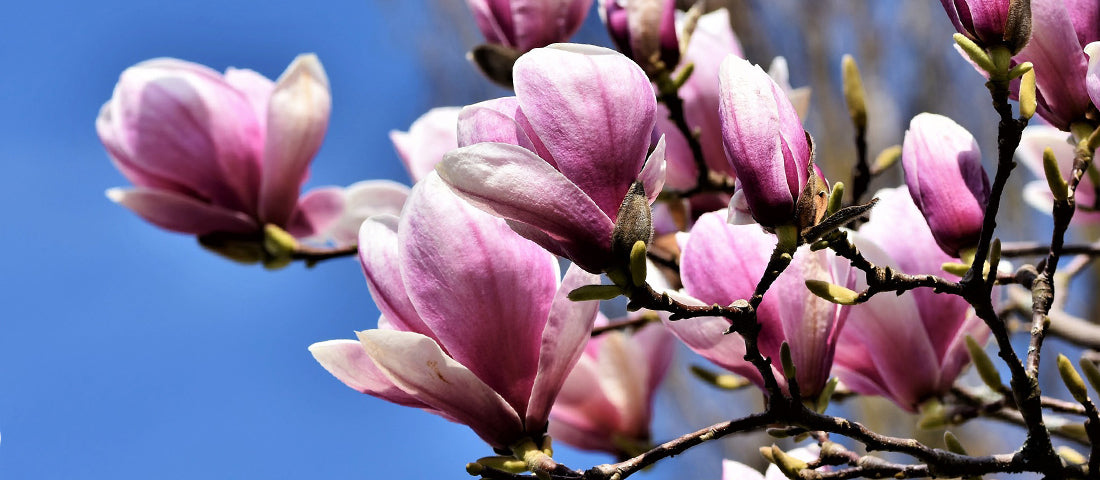
Next door has a garden with a magnolia tree. While for most of the year it’s a handsome tree, for these few weeks in spring it is nothing short of absolutely magnificent. While delicate crocus are peeping shyly through cold soil at ground level, this beautiful bold magnolia explodes into flamboyant pink and white flower, crying ‘Spring is here!’ to all and sundry. And aren’t we all ready to hear that? It brings joy to the whole neighbourhood.
Magnolias are much-loved garden trees, and in the spring it’s easy to see just how popular they are. The eye-catching blooms are easy to spot as in deciduous magnolias they flower on bare stems, at a time when little else is in leaf. Ranging in colour from pure white to almost purple and even some creamy yellows, they bring exuberant colour to landscapes which have been painted in dowdy tones for too long over the winter.


Magnolias are a mind-bogglingly ancient family in the plant kingdom. Plants identifiable as belonging to the Magnoliaceae family have been put at around 95 million years old. 95 million. That’s at the start of the late Cretaceous period, even before dinosaurs such as Tyrannosaurus Rex came on the scene. In fact, this branch of the family tree is so unbelievably ancient, it predates the evolution of bees. It’s thought that magnolias evolved to be pollinated by beetles – hence the sturdy, almost leathery petals, produced to support crawling beetles rather than flying insects.
Like other ancient species which have survived to the modern day, including ferns, moss and ginkgos, they’re incredibly successful at what they do, attracting the perfect pollinator at exactly the right time of year. The fact that they do it using huge, colourful and often fragrant flowers is a happy coincidence for we humans, able to enjoy them in our gardens.
Magnolias are predominantly northern hemisphere plants, ranging from Asia to the Americas. Being so ancient, they survived ice ages, continental drift and mountain formation, and fossil records show that they were also once indigenous in Europe. Today there are over 200 species from east and southeast China, from south, central and north America, and from the West Indies.

They’re useful beyond their beauty in our gardens, though. In Asia the flower buds of Magnolia salicifolia are used to treat headaches and allergies. And did you know that the petals can be eaten? We’ve not tested this, but apparently they have a spicy flavour with notes of clove and ginger. They work well is salads, teas, fried in tempura batter and even pickled, as an alternative to pickled ginger. Find out more about culinary uses for magnolia.
If you’re a little in love with magnolias too, and fancy enjoying their splendour in your garden each spring, you may be tempted to plant one. Before you buy, be sure to check how big your chosen specimen is likely to get, as some magnolias can reach 30m tall. Remember, these are prehistoric giants! Species magnolias can also take upwards of 15 years to start flowering, so you’ll need to be patient, too.

Happily, there are also many smaller magnolias more suited to today’s smaller gardens, and many modern hybrids flower after only a few years. If you’re after a small tree or even a shrub, there are also plenty of options.
Magnolia x soulangeana is one of the most popular smaller magnolias, also known as the tulip, saucer or Chinese magnolia. Happy in full sun or partial shade in a well-drained soil, it has ivory flowers flushed with pink which open out into saucer shapes before they fall. You can expect a height and spread of 6 x 4 metres in 20 years.

Going even smaller, Magnolia stellata, the star magnolia, is another popular option. This delicate Japanese magnolia is really more of a shrub than a tree and can even be grown in containers. With a height of just 3m, the white star-shaped blooms can be enjoyed in most gardens. It’s naturally a woodland plant, so is more tolerant of shade than some other magnolias.
Magnolias are generally easy to care for. They prefer a sheltered spot, away from strong winds. They don’t like waterlogged ground, so good drainage is key. They’re hardy and can withstand a frost, although sadly a late frost after the flower buds have formed can cause the buds to drop, affecting the tree’s flowering that year.
Fortunately, this year this has not been the case, in our neck of the woods at least. The magnolia in next door’s garden is flowering profusely, and the whole neighbourhood is enjoying these few sublime weeks as this magnificent magnolia heralds the arrival of spring.

